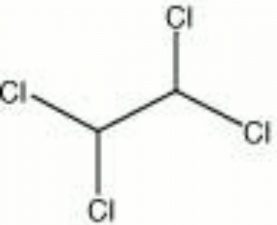Tetrachloroethane
Jump to navigation
Jump to search
Description
A clear, sweet-smelling, viscous liquid. Tetrachloroethane was formerly used as a solvent for fats, oils, waxes, resins, plastics, Cellulose acetate, Rubber, Copal, and Sulfur. It was also used in the manufacture of paint and varnish removers and in the production of insecticides, weed killers, and fumigants. Tetrachlorethane is suspected to be a carcinogen.
Synonyms and Related Terms
acetylene tetrachloride; sym-tetrachloroethane; Cellon; Bonoform
Risks
- Nonflammable. Decomposes on contact with flame or UV light to form toxic fumes (phosgene and hydrogen chloride).
- Potential carcinogenic.
- Toxic by ingestion, inhalation and skin absorption.
- ThermoFisher: SDS
Physical and Chemical Properties
Miscible with methanol, ethanol, benzene, ether, carbon tetrachloride, chloroform carbon disulfide, dimethylformamide, oils. Slightly soluble in water.
| Composition | CHCl2CHCl2 |
|---|---|
| CAS | 79-34-5 |
| Melting Point | -44 C |
| Density | 1.587-1.593 g/ml |
| Molecular Weight | mol. wt. = 167.9 |
| Refractive Index | 1.49419 |
| Boiling Point | 146.5 C |
Resources and Citations
- G.S.Brady, Materials Handbook, McGraw-Hill Book Co., New York, 1971 Comment: p. 805
- Richard S. Lewis, Hawley's Condensed Chemical Dictionary, Van Nostrand Reinhold, New York, 10th ed., 1993
- Michael McCann, Artist Beware, Watson-Guptill Publications, New York City, 1979
- The Merck Index, Martha Windholz (ed.), Merck Research Labs, Rahway NJ, 10th edition, 1983 Comment: entry 9331
